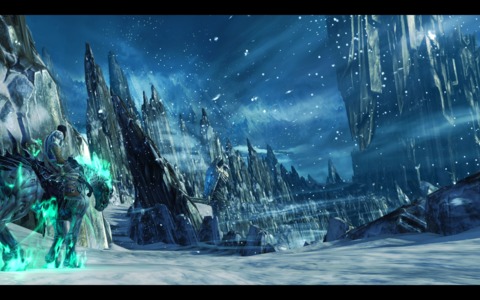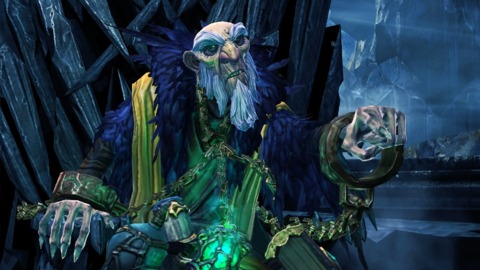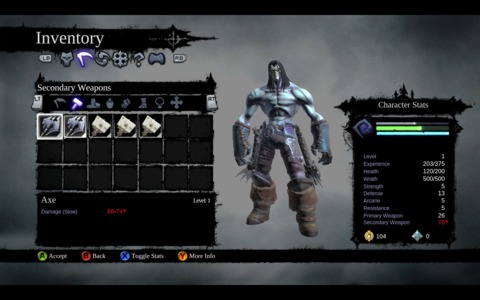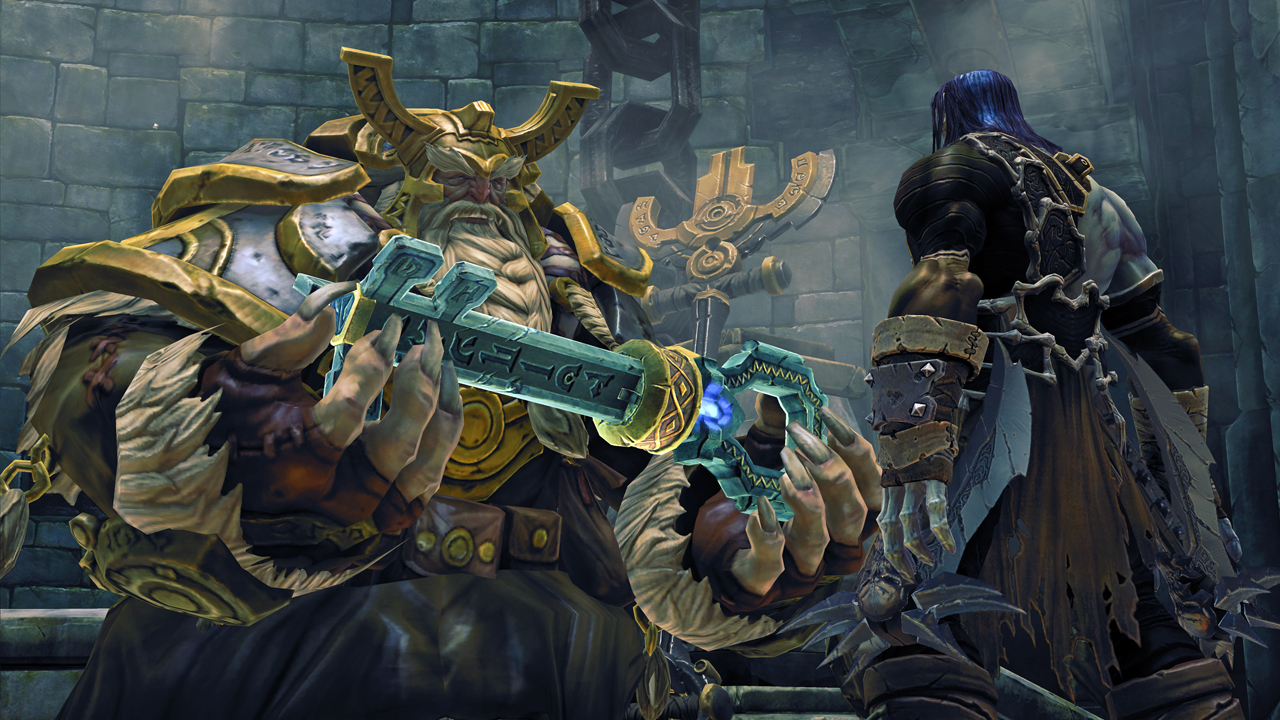Darksiders II Review

2010's Darksiders was a cool surprise, an action-heavy apocalyptic epic that beat The Legend of Zelda at its own game by freshening up the combat and pulling in a lot of ideas that trace back to a lot of different places. It sparked a lot of conversation about the blurry line between the honorable homage and the straight-up jack move, and it felt like most folks ended up on the homage side of the line. Honestly, it was easy to feel that way because Darksiders was a really good game. So how do you produce a sequel to all that? Rather than staring at someone else's playbook, Vigil Games has taken the core ideas of the original Darksiders and built upon them in a natural way. You can still pick out a few things here and there that tie it to the products of gaming's past, but those inspirations aren't quite as clear cut, making Darksiders II feel like a smart, original evolution of the previous game's concepts with plenty of new things to see and do, from its new protagonist to its faster combat and engaging loot system.
In Darksiders II you play as Death, one of the other four horsemen of the apocalypse. War, the "hero" of the last game, isn't too popular in this battle between angels and demons, and Death is out to clear War's name and, assuming he can figure out the logistics, resurrect humanity along the way. You'll have a better time with the game if you're at least somewhat familiar with the original game's story, though if you're hazy on the facts, the game references just enough of them to bring you back up to speed. But other than setting out to put right the things that went wrong in the previous game, Darksiders II feels like its own adventure. The ties to the previous game feel more like nice bonuses for people who played that game than absolutely crucial details. Instead, much of the game deals with Death's attempts to reach the Tree of Life and/or the Well of Souls, powerful places that are said to be capable of bringing all of humanity back to life--the blame for that action currently lies at War's feet, after all. Of course, it's not exactly a simple A-to-B-to-C sort of story.

Everyone wants something and no one's going to help out a horseman for free. So like any other proper video game protagonist, you're going to spend most of the 20-25 hours helping out the people around you. It starts by getting a forge going and discovering that much of the world in Darksiders II is overcome by corruption. This force is creeping across all the realms, infecting enemies and even the land itself, which is peppered with glowing rock formations that can be destroyed with bomb flowers. You'll work your way through multiple realms, each with its own version of the Tree of Life (or Death, as the case may be) and its own unique landscape and features. The story pushes you from one quest giver to the next, and everyone seems to have a few things for you to collect, be it the two keys, three parts of a staff, and so on. Though the story may be pretty straightforward, the dialogue is well-written and acted well, giving the game a weighty feel, overall.
Getting around the world is made easy via a very lax fast travel system, which has positive and negative impacts on the world. It's great to not have to ride your horse across huge, empty areas just to get to where you're going, but fast traveling from the realm's shopkeeper to the dungeon you're currently fighting through and back again robs the world of its sense of scale. It's almost certainly a gigantic world when compared to the first Darksiders--but it doesn't feel especially big, moreso if you're not focusing on every single one of the game's side quests, which can add a substantial number of hours to your play time.
Combat is fast and offers an upgradable combo system that makes it about more than just mashing the buttons, though if you're properly equipped and have spent your skill points in a complimentary way, mashing the buttons works pretty well around 95 percent of the time. Much of the combat focuses on landing a bunch of hits and dodging out of the way when a counterattack is headed in your direction. But if you've got faster weapons equipped and carefully curate your statistics to keep your health up and enemies staggered, combat is never a chore. Even many of the game's boss fights don't require specific mechanics to succeed, so you can skip the tricks and face your enemies head-on, if you like. Many of those boss battles get a lot easier if you're thinking outside of the box, though. One section of the adventure attempts to change things up by turning the game into a third-person shooter, but the camera system and controls just weren't built for this feat, making the entire section feel pretty terrible. It's one of the few blemishes in Darksiders II.

As you kill, you earn experience points and gain levels. This earns you skill points that are spent on a two-sided skill tree, with one set of abilities focuses on direct damage and strength increases and the other offering a more magical route of spawnable ghouls that fight by your side, defensive bonuses, and crows that show up to attack on your behalf. Yet another meter controls your ability to activate "reaper mode," which turns death into a large, more traditional take on the Grim Reaper that swings scythes around and does more damage. It's neat, but sort of a mess, as it's usually difficult to make out what the hell is going on. Just keep the Z-targeting button held down and mash the attacks, everything will be fine.
Some of the game's loot is also keyed to your character level, but the loot that drops is usually right at your level, so cases where you're picking up something you can't use yet are few and far between. There are several armor points on Death, so you can equip shoulders, a chest piece, boots, arm wraps, and a talisman. Death's primary weapon is always a set of scythes, but you can equip different secondary weapons, like huge hammers, maces, and axes or smaller arm blades that deal fast damage. The loot is color-coded and comes with a lot of different statistical bonuses, like "thorns" and "health on crit" or more standard upgrades like strength and defensive upgrades. The game also has a weapon upgrade system that lets you take special possessed weapons and level them up by feeding your other weapons to them. As you feed a possessed weapon, it increases in power and inherits some of your old weapons' special abilities. So if you have stats that you really prefer, you can feed those stats to a possessed weapon to keep it growing in a set direction. It's a cool system that makes each piece of loot meaningful, but if your playthrough is anything like mine, you'll probably only find two or three possessed weapons over the course of the game. Since possessed weapons cap out after leveling up five times, you'll eventually reach a point where you have no more abilities to buy, no more weapons to feed, and no real reason to keep collecting inferior loot at all, since it's so easy to earn money as you play. I finished the game with more money than I could ever reasonably spend and nothing to spend it on other than the occasional health potion.

Though Death isn't as bulky as War was, the Darksiders visual style remains intact. Even the townsfolk and shopkeepers in this world look incredibly tough and thick. But the game never lets its tone fall too far into generically grimdark territory. There's a lot of great design and art to look at as you work your way through the realms. The technical side of Darksiders II isn't as laudable, especially on consoles, where the frame rate gets rough when the action picks up and little things like shadow detail are noticeably drawing in as you run around. The PC version is a sharper, better looking game, but people who like to go overboard on the options will find Darksiders II's lack of checkboxes and sliders to be a little disappointing.
The adventure has its rough spots and the technical issues are disappointing, but these are relatively small issues in the grand scheme of things. Darksiders II is an exciting and lengthy adventure with interesting characters and a host of items and features that make its mix of combat and puzzle-solving very attractive. It's better if you also played the original game, but even if you didn't, Darksiders II is definitely worth looking at.
